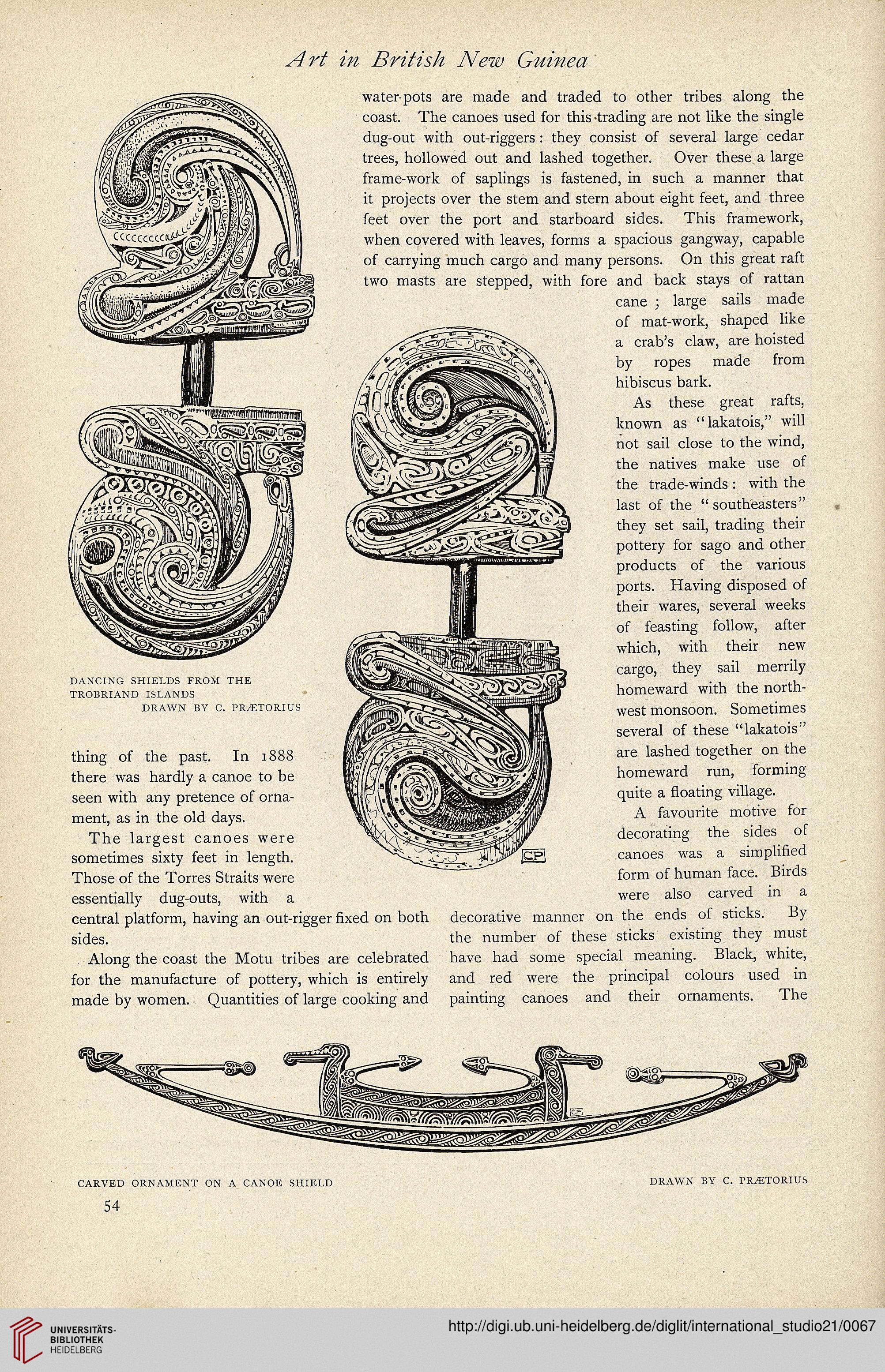A' 777 (?777 77^77
DANCING SHIELDS FROM THE
TROBRIAND ISLANDS
DRAWN BY C. PRAETOR! US
thing of the past. In 1888
there was hardly a canoe to be
seen with any pretence of Orna-
ment, as in the old days.
The largest canoes were
sometimes sixty feet in iength.
Those of the Torres Straits were
essentially dug-outs, with a
central platform, having an out-rigger Hxed on both
sides.
Along the coast the Motu tribes are celebrated
for the manufacture of pottery, which is entirely
made by women. Quantities of large cooking and
water-pots are made and traded to other tribes along the
coast. The canoes used for this -trading are not like the single
dug-out with out-riggers : they consist of several large cedar
trees, hollowed out and lashed together. Over these a large
frame-work of saplings is fastened, in such a manner that
it projects over the stem and Stern about eight feet, and three
feet over the port and starboard sides. This framework,
when covered with leaves, forms a spacious gangway, capable
of carrying much cargo and many persons. On this great raft
two masts are stepped, with fore and back stays of rattan
cane ; large sails made
of mat-work, shaped like
a crab's claw, are hoisted
by ropes made from
hibiscus bark.
As these great rafts,
known as "lakatois," will
not sail close to the wind,
the natives make use of
the trade-winds : with the
last of the "southeasters"
they set sail, trading their
pottery for sago and other
products of the various
ports. Having disposed of
their wares, several weeks
of feasting follow, after
which, with their new
cargo, they sail merrily
homeward with the north-
west monsoon. Sometimes
several of these "lakatois*'
are lashed together on the
homeward run, forming
quite a Soating village.
A favourite motive for
decorating the sides of
canoes was a simplihed
form of human face. Birds
were also carved in a
decorative manner on the ends of sticks. By
the number of these sticks existing they must
have had some special meaning. Black, white,
and red were the principal colours used in
painting canoes and their Ornaments. The
CARVED ORNAMENT ON A CANOE SHIELD
DRAWN BY C. TRAITORIUS
54
DANCING SHIELDS FROM THE
TROBRIAND ISLANDS
DRAWN BY C. PRAETOR! US
thing of the past. In 1888
there was hardly a canoe to be
seen with any pretence of Orna-
ment, as in the old days.
The largest canoes were
sometimes sixty feet in iength.
Those of the Torres Straits were
essentially dug-outs, with a
central platform, having an out-rigger Hxed on both
sides.
Along the coast the Motu tribes are celebrated
for the manufacture of pottery, which is entirely
made by women. Quantities of large cooking and
water-pots are made and traded to other tribes along the
coast. The canoes used for this -trading are not like the single
dug-out with out-riggers : they consist of several large cedar
trees, hollowed out and lashed together. Over these a large
frame-work of saplings is fastened, in such a manner that
it projects over the stem and Stern about eight feet, and three
feet over the port and starboard sides. This framework,
when covered with leaves, forms a spacious gangway, capable
of carrying much cargo and many persons. On this great raft
two masts are stepped, with fore and back stays of rattan
cane ; large sails made
of mat-work, shaped like
a crab's claw, are hoisted
by ropes made from
hibiscus bark.
As these great rafts,
known as "lakatois," will
not sail close to the wind,
the natives make use of
the trade-winds : with the
last of the "southeasters"
they set sail, trading their
pottery for sago and other
products of the various
ports. Having disposed of
their wares, several weeks
of feasting follow, after
which, with their new
cargo, they sail merrily
homeward with the north-
west monsoon. Sometimes
several of these "lakatois*'
are lashed together on the
homeward run, forming
quite a Soating village.
A favourite motive for
decorating the sides of
canoes was a simplihed
form of human face. Birds
were also carved in a
decorative manner on the ends of sticks. By
the number of these sticks existing they must
have had some special meaning. Black, white,
and red were the principal colours used in
painting canoes and their Ornaments. The
CARVED ORNAMENT ON A CANOE SHIELD
DRAWN BY C. TRAITORIUS
54




